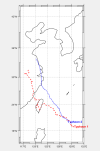Hi all,
Recently, I used WRFV4.2 simulating Typhoon Lekima (2019).I have found that the timing of the namelist setting makes a huge difference in the results. As shown in the figure, the simulation start time of typhoon is 2019-08-01, and the simulation start time of typhoon 2 is 2019-08-07. The simulation duration of typhoon 1 is 13 days, and the simulation duration of typhoon 2 is 6 days. The parts where the time overlaps are shown in the figure, and the difference is huge. The simulation of Typhoon 2 is close to the actual situation. What is the reason for this? If the simulations start and end at different times, would the partial results of the time crossing of 2 simulations differ so drastically?How to improve to solve this problem?

Recently, I used WRFV4.2 simulating Typhoon Lekima (2019).I have found that the timing of the namelist setting makes a huge difference in the results. As shown in the figure, the simulation start time of typhoon is 2019-08-01, and the simulation start time of typhoon 2 is 2019-08-07. The simulation duration of typhoon 1 is 13 days, and the simulation duration of typhoon 2 is 6 days. The parts where the time overlaps are shown in the figure, and the difference is huge. The simulation of Typhoon 2 is close to the actual situation. What is the reason for this? If the simulations start and end at different times, would the partial results of the time crossing of 2 simulations differ so drastically?How to improve to solve this problem?

Attachments
Last edited:
